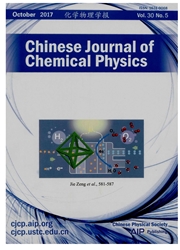

 中文摘要:
中文摘要:
聚合物链的有弹性的行为在一个三维的离开格子模型被调查。我们由使用一个蒙特卡罗算法取样每种聚合物链的超过 10 9 符合构造,然后与橡皮状的弹性的 non-Gaussian 理论分析他们,并且与统计研究结束。通过在吝啬平方的端对端的距离上观察链灵活性和拉长的比率的效果,平均精力,平均 Helmholtz 免费精力,有弹性的力量,到有弹性的力量的精力的贡献,和对聚合物的有弹性的力量的熵贡献锁住,我们发现僵硬聚合物链容易得多比灵活聚合物链拉长。另外,因为熵贡献的效果,僵硬聚合物链将仅仅在相当高的拉长比率对段变得困难。我们的模拟计算的这些结果可以解释一些聚合物和 biomacromolecular 弹性的宏观的现象。
 英文摘要:
英文摘要:
The elastic behavior of the polymer chain was investigated in a three-dimensional off-lattice model. We sample more than 109 conformations of each kind of polymer chain by using a Monte Carlo algorithm, then analyze them with the non-Gaussian theory of rubberlike elasticity, and end with a statistical study. Through observing the effect of the chain flexibility and the stretching ratio on the mean-square end-to-end distance, the average energy, the average Helmholtz free energy, the elastic force, the contribution of energy to the elastic force, and the entropy contribution to elastic force of the polymer chain, we find that a rigid polymer chain is much easier to stretch than a flexible polymer chain. Also, a rigid polymer chain will become difficult to stretch only at a quite high stretching ratio because of the effect of the entropy contribution. These results of our simulation calculation may explain some of the macroscopic phenomena of polymer and biomacromolecular elasticity.
 同期刊论文项目
同期刊论文项目
 同项目期刊论文
同项目期刊论文
 Complex micelles from the self-assembly of coil-rod-coil amphiphilic triblock copolymers in selectiv
Complex micelles from the self-assembly of coil-rod-coil amphiphilic triblock copolymers in selectiv Microstructures from a mixture of ABC 3-miktoarm star terpolymers and homopolymers in two-dimensiona
Microstructures from a mixture of ABC 3-miktoarm star terpolymers and homopolymers in two-dimensiona Developing a coarse-grained force field for the diblock copolymer poly(styrene-b-butadiene) from ato
Developing a coarse-grained force field for the diblock copolymer poly(styrene-b-butadiene) from ato Effect of surface field on the morphology of a symmetric diblock copolymer under cylindrical confine
Effect of surface field on the morphology of a symmetric diblock copolymer under cylindrical confine Influence of electric field on the phase transitions of the hexagonal cylinder phase of diblock copo
Influence of electric field on the phase transitions of the hexagonal cylinder phase of diblock copo Fusion and fission pathways of vesicles from amphiphilic triblock copolymers: a dissipative particle
Fusion and fission pathways of vesicles from amphiphilic triblock copolymers: a dissipative particle Cooperative surface-induced self-assembly of symmetric diblock copolymers confined films with embedd
Cooperative surface-induced self-assembly of symmetric diblock copolymers confined films with embedd Shape Transformations of Membrane Vesicles from Amphiphilic Triblock Copolymers: A Dissipative Parti
Shape Transformations of Membrane Vesicles from Amphiphilic Triblock Copolymers: A Dissipative Parti Microphase separation of diblock copolymer poly(styrene-b-isoprene): A dissipative particle dynamics
Microphase separation of diblock copolymer poly(styrene-b-isoprene): A dissipative particle dynamics Canonical and microcanonical analysis of nongrafted homopolymer adsorption by an attractive substrat
Canonical and microcanonical analysis of nongrafted homopolymer adsorption by an attractive substrat 期刊信息
期刊信息
